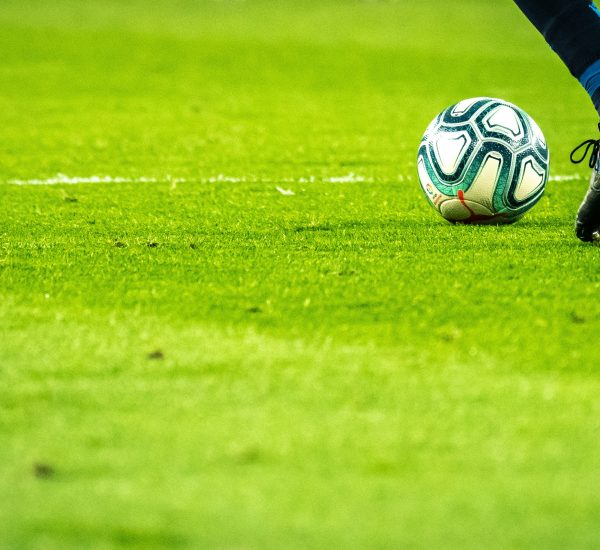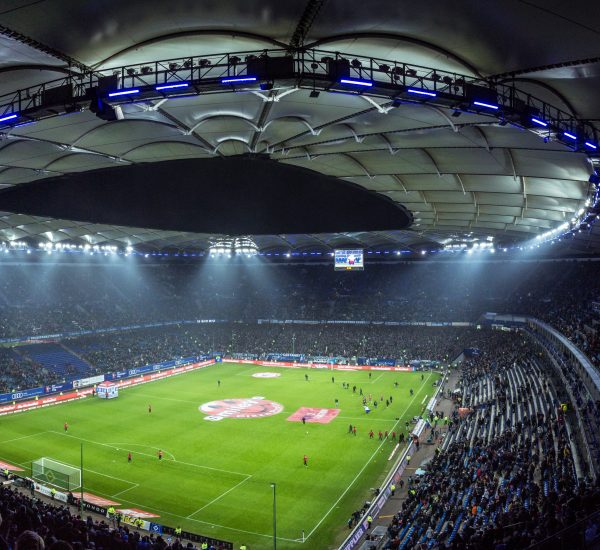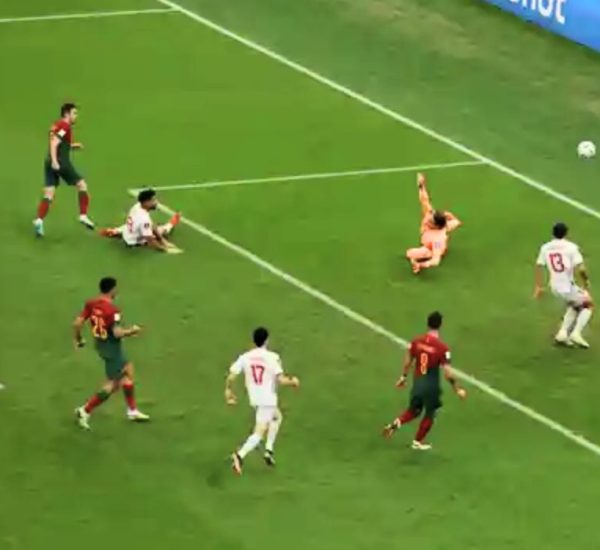Manchester United is a professional soccer team from England which competes in the English Premier League. They are the team with the biggest fan-base in England and the third most followed team worldwide.
Nicknamed “The Red Devils”, Manchester United play their home games at Old Trafford. The stadium can accommodate 74,140 fans. Manchester United hold the record for the most First Division/Premier League trophies won (20 titles). They are also successful in European competitions, having won 3 UEFA Champions League trophies, 1 UEFA Europa League, 1 FIFA Club World Cup, and 1 European Super Cup.
Mostly known for their aggressive playing style under Sir Alex Ferguson, Manchester United is a dominant sports powerhouse and a great soccer institution. Let us have a look at the history of the Old Trafford club.
| Full Name | Manchester United FC |
|---|---|
| Founded | In 1878 as Newton Heath LYR F.C. In 1902 as Manchester United F.C. |
| Nickname | The Red Devils |
| Stadium | Old Trafford |
| Capacity | 74,140 |
| Owner | Glazer family |
| Manager | Ole Gunnar Solskjær |
| League | Premier League |
Foundation Of Manchester United And Early Years
The year 1878 marked the formation of Manchester United. The club was previously known as Newton Heath LYR Football Club. The Red Devils were set up by workers at the Carriage and Wagon department of the Lancashire and Yorkshire Railway depot at Newton Heath.
For several years, the team played in the regional soccer league before making its entrance to the First Division in 1892. However, United’s spell in the top-flight was brief. The club was relegated a couple of years after their debut, following play-off defeat at Second Division champions Liverpool FC.
Later, in 1902, club captain Harry Stafford and other business people, including John Henry Davies, bought the club to save it from liquidation. Subsequently, Henry was elected as President, and the team was renamed Manchester United Football Club. It was also the same year the club started wearing the famous red and white jersey.
First Silverware And Old Trafford
Under Ernest Mangnall’s leadership, Manchester United won back promotion to the First Division in 1906, twelve years after their relegation. Mangnall, who managed to sign several star players, namely Billy Meredith and Sandy Turnbull, steered the club to its first-ever league title in 1908. A FA Cup win followed the club’s first major title in the next season and another league title in 1911.
During the same period, with the financial backing of John Henry, the club acquired a plot of land. The land turned into the famous Old Trafford. While the Red Devils’ future and fortunes looked promising, the departure of Mangnall to Manchester City FC marked the end of a successful era and the start of a steady decline. United soon became a yo-yo club, fighting relegation and promotion for several years.
Sir Matt Busby And The Munich Disaster
In 1945, Sir Matt Busby, a former Manchester City and Liverpool FC player, joined Manchester United as head coach. Optimism started to grow among the fans. The ongoing Second World War was still in the back of everyone’s mind. Besides, the club’s dreadful performances nearly led to relegation to the Third Division.
The Scot who went on an illustrious 25 years’ career with Manchester United is regarded as an influential figure in its success. He instantly impacted as the team finished second to Liverpool FC in his first season (1946-47). In the following campaign, United defeated Blackpool FC to win the FA Cup, 39 years since the club last won a major trophy.
During his time, Busby would introduce several local young talents to the team. These young players, who were nicknamed ‘The Busby Babes’, were instrumental in bringing back glory to the club. In the 1951/52 campaign, a 41-years’ wait came to an end, as the club were crown league champions.
On 5 February 1958, Manchester United travelled to Yugoslavia for their European Cup quarter-finals’ second leg. The team drew 3-3 against Red Star Belgrade but qualified for the semi-finals thanks to a 2-1 home win. On their return, the team’s chartered plane stopped at Munich Airport for refuelling.
Due to engine problems, take-off had to be aborted twice. On the third attempt, as the plane was about to take off, the airspeed significantly dropped. It led the aircraft off the runway to finish its course against a house. As a result of the crash, 22 people lost their lives, including seven players. To this day, the tragedy is still mourned by Manchester United and by the wider soccer community.
The Red Devils
As Busby was recovering from his injuries, Jimmy Murphy took over, and the club managed to reach the FA Cup Final, losing to Bolton Wanderers. In the 1960s, the arrival of Denis Law, Bobby Charlton and George Best saw a formidable partnership, known as ‘The United Trinity’. Their incredible performances and goals galore would turn the club into a dominating force in both England and Europe.
During their time at the club, all three players won the Ballon d’Or. As a tribute to their contribution, a statue, The United Trinity, can be seen outside Old Trafford.
With a more mature team at his disposal, Sir Matt Busby labelled his players as ‘The Red Devils’. The name originates from ‘Les Diables Rouges’, a term used by the French media to describe Salford, an English rugby club, after they toured France in their red jerseys.
Busby felt it would suit his team’s aggressive playing style and intimidate opponents compared to ‘The Busby Babes’. Subsequently, this resulted in incorporating the famous devil logo in the badge and merchandise of the club.
European Success And Post-Busby
In 1967-68, Manchester United defeated Benfica 4-1 (a.e.t) in the European Cup final at Wembley Stadium. Three extra-time goals from Bobby Charlton, George Best, and Brian Kidd were more than enough for the club to claim their first-ever European Cup. It was the last trophy won by Busby as he retired at the end of the 1969 campaign. During his tenure, the Scot led the club to 5 league titles, 2 FA Cups and 1 European Cup.
There was immense pressure to iterate Busby’s accomplishment. After the short and unsuccessful tenure of Wilf McGuiness and Frank O’Farrell, Tommy Docherty was appointed as manager in December 1972.
Docherty could not perform better than his predecessors, and eventually, the club was relegated to the Second Division in 1973-74. However, Manchester United secured promotion immediately after finishing first in the subsequent season. In 1977, Docherty led the team to an FA Cup triumph over Liverpool FC. It would be his only silverware as manager since he was soon sacked and replaced by Dave Sexton.
The failure to deliver silverware led to the sacking of Sexton after four years at the hot seat. He was shortly replaced by Ron Atkinson, who led the team at the beginning of the 1981-82 campaign. Atkinson took little time to instil his authority upon the group. He recruited several influential players and later broke the British transfer record to sign Bryan Robson.
The move paid off as the club won 2 FA cups (1983 and 1985) in 3 seasons. Although Atkinson managed to bring back silverware to the club, he could not deliver the league title back to Old Trafford. He was eventually sacked at the end of the 1985/86 campaign.
The Sir Alex Ferguson Era
After several failed attempts to win the league, Manchester United finally set their sights on a man with a proven winning pedigree. After his successful spell at Aberdeen Football Club, Alex Ferguson was appointed in November 1986.
Despite a slow start to his managerial career, Alex Ferguson finally delivered his first silverware to the club by winning the FA Cup in 1990. The next campaign saw the club win the European Cup Winners’ Cup, ending a 23 years’ wait for European success. Two goals from Mark Hughes helped the team beat Barcelona 2-1 in the final.
In December 1992, Manchester United signed Eric Cantona from their arch-rival, Leeds United. The star player’s recruitment would prove instrumental as The Red Devils finally won the league title in 1992-93. Alex Ferguson delivered his first of many league titles to the club, ending a 26 years’ wait since Manchester United last won the league title.
In the next campaign (1993-94), Ferguson led the team to a historic double, winning both the league title and the FA Cup. A feat he would reiterate in 1995-96 and 1998-99 seasons. A new era of success was being written at the club, as silverwares would keep flowing at Old Trafford.
Sir Alex Ferguson was a ruthless leader and a man with great self-confidence. His vision and winning mentality would resonate throughout the clubs and players that he managed. He is also known as a person who expected good discipline and strong character from his players on-and-off the pitch.
During his tenure, Ferguson was known for his bold and aggressive transfer spree. Significant investment into the squad allowed him to deliver silverware consistently. Over the years, he made countless recruitment, breaking the transfer fee records on several occasions.
Class Of 92 And Treble Winner
The Class of 92 is another success story of the Ferguson Era. Talented players that were part of the Class of 92 were David Beckham, Nicky Butt, Ryan Giggs, Gary Neville, Phil Neville and Paul Scholes. They were notably known as the golden generation of players that peaked in the 1998-99 season and played a major role in the club’s success.
In 1999, Manchester United went into the history books as the first English team to win the treble. Having already been crowned champions of the Premier League and FA Cup, the club went into the UEFA Champions League Final as the underdogs. Thanks to injury-time goals from Teddy Sheringham and Ole Gunnar Solskjaer, Manchester United made a historic comeback to beat Bayern Munich FC 2-1.
The Living Legend Of Manchester United
After his heroics and contribution to English soccer, Alex Ferguson was knighted in June 1999. The man is known for his unique man-management skills and ability to get the best out of his squad. Ferguson managed and signed some incredible players during his career.
Ferguson signed players like Mark Hughes, Peter Schmeichel, Eric Cantona, Roy Keane, Ruud Van Nistelrooy, Rio Ferdinand, Christiano Ronaldo, and Wayne Rooney.
Sir Alex Ferguson went on to be the longest-serving manager in the club’s history, a record previously held by Sir Matt Busby. During his 26 years spell at the club’s helm, he won a massive 38 trophies, including 13 League titles, 5 FA Cups, and 2 UEFA Champions Leagues.
At the end of the 2012-13 season, Sir Alex Ferguson finally resigned as manager, putting an end to a historical era. Following his decision to leave, he was abundantly praised as the most outstanding and most successful manager of all time by the soccer fraternity. Today, he remains an active figure as the Director and Ambassador of Manchester Football Club.
Post Ferguson Era
By the end of Ferguson’s era, Chelsea FC and Manchester City FC, both backed by their wealthy owners, would put an end to the dominance of The Red Devils. After Alex Ferguson’s resignation, David Moyes was appointed to continue the legacy left behind by his predecessor.
Despite his excellent track record at his previous employer, Everton FC, David Moyes failed to maintain the team’s status. He was sacked within 12 months at the club and was temporarily replaced by club legend Ryan Giggs until the end of the season.
The following season, Louis Van Gaal, a man with a proven pedigree, was appointed. There was a lot of optimism upon his arrival, and the man took little time to instil his authority. He made several marquee signings and even broke the club transfer fee record by recruiting Angel Di Maria from Real Madrid FC.
In his second year with the club, Van Gaal was intriguingly sacked despite winning the FA Cup. Manchester United was a title-winning team, and the team’s inability to challenge the league title was getting on the board members’ nerves.
Jose Mourinho Appointment As Manchester United Coach
In May 2016, in the quest to restore the club to glory, Manchester United appointed Jose Mourinho, also known as the Special One. Having won league titles with four clubs in 4 different countries, including Chelsea FC, Mourinho had the perfect profile to bring back the Premier League crown.
Like Van Gaal, Mourinho brought several players to the club, including the new club-record signing, Paul Pogba. In his first season, the Special One did not disappoint, as he won the Community Shield, the League Cup and the Europa League.
In his second spell at the Club, Mourinho guided the team to a second-place finish in the league; it was the club’s best league performance since Sir Alex Ferguson’s departure. However, despite reinforcing the team’s attacking options with Romelu Lukaku and Alexis Sanchez, the team finished the season empty-handed.
In December 2018, with the team seemingly out of the title contention, Jose Mourinho was sacked. Before his departure, Mourinho had an ongoing feud with some of his star players and mentioned his disagreement over the club’s transfer policies.
Ole Gunnar Solskjaer (2018 – Present)
After Jose Mourinho’s sacking, club legend Ole Gunnar Solskjaer was appointed as caretaker manager for the rest of the campaign. Following an impressive 14 wins in 19 matches in the league, Solskjaer appointment was made permanent for three years.
Despite not winning any silverware since his arrival, Solsjkaer’s management approach and recruitment policy have been praised, as the team is starting to click again. With the marquee signings of Harry Maguire, Aaron Wan-Bissaka, Daniel James and Bruno Fernandes, and the promotion of academy talents such as Scott McTominay and Mason Greenwood, there is hope that the old glory days will be back sooner than later.



